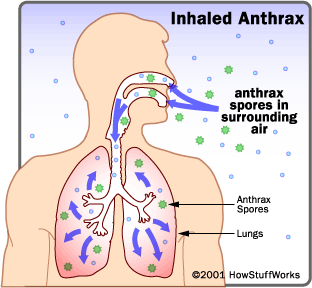French physician Casimir Davaine (1812-1882) demonstrated the symptoms of anthrax were invariably accompanied by the microbe B. anthracis. German physician Aloys Pollender (1799–1879) is credited for discovery. B. anthracis was the first bacterium conclusively demonstrated to cause disease, by Robert Koch in 1876. The species name anthracis is from the Greek anthrax (ἄνθραξ), meaning "coal" and referring to the most common form of the disease, cutaneous anthrax, in which large, black skin lesions are formed. Throughout the 19th century, Anthrax was an infection that involved several very important medical developments. The first vaccine containing live organisms was Louis Pasteur's veterinary
Bacillus anthracis
Photomicrograph of Bacillus anthracis (fuchsin-methylene blue spore stain)
Scientific classification
Phylum: Firmicutes
Class: Bacilli
Order: Bacillales
Family: Bacillaceae
Genus: Bacillus
Species: B. anthracis
Binomial name
Bacillus anthracis
Bacillus anthracis is the etiologic agent of anthrax.This disease can be classified as a zoonosis, causing infected animals to transmit the disease to humans.
· B. anthracis is a Gram-positive, endospore-forming, rod-shaped bacterium,Endospore forming, with a width of 1.0–1.2 µm and a length of 3–5 µm.
· It can be grown in an ordinary nutrient medium under aerobic or facultative anaerobic conditions..
Symptoms
The symptoms of anthrax depend on the type of infection and can take anywhere from 1 day to more than 2 months to appear. All types of anthrax have the potential, if untreated, to spread throughout the body and cause severe illness and even death.
Cutaneous anthrax symptoms can include:
- A group of small blisters or bumps that may itch
- Swelling can occur around the sore
- A painless skin sore (ulcer) with a black center that appears after the small blisters or bumps
- Most often the sore will be on the face, neck, arms, or hands
Inhalation anthrax symptoms can include:
- Fever and chills
- Chest Discomfort
- Shortness of breath
- Confusion or dizziness
- Cough
- Nausea, vomiting, or stomach pains
- Headache
- Sweats (often drenching)
- Extreme tiredness
- Body aches
- Fever and chills
- Swelling of neck or neck glands
- Sore throat
- Painful swallowing
- Hoarseness
- Nausea and vomiting, especially bloody vomiting
- Diarrhea or bloody diarrhea
- Headache
- Flushing (red face) and red eyes
- Stomach pain
- Fainting
- Swelling of abdomen (stomach)

Injection anthrax symptoms can include:
- Fever and chills
- A group of small blisters or bumps that may itch, appearing where the drug was injected
- A painless skin sore with a black center that appears after the blisters or bumps
- Swelling around the sore
- Abscesses deep under the skin or in the muscle where the drug was injected
To Keep in Mind
Injection anthrax symptoms are similar to those of cutaneous anthrax, but injection anthrax can spread throughout the body faster and be harder to recognize and treat than cutaneous anthrax. Skin and injection site infections associated with injection drug use are common and do not necessarily mean the person has anthrax.
Injection anthrax symptoms are similar to those of cutaneous anthrax, but injection anthrax can spread throughout the body faster and be harder to recognize and treat than cutaneous anthrax. Skin and injection site infections associated with injection drug use are common and do not necessarily mean the person has anthrax.
Specimens collection
- To test directly for Bacillus anthracis in a sample
- blood
- skin lesion swab
- spinal fluid
- respiratory secretions
Samples must be taken before the patient begins taking antibiotics for treatment.
Laboratory Diagnosis
Gram positive bacilli ( rod), endospore
Bacterial
|
Bacillus anthracis
|
growth
| |
Blood agar
|
non hemolytic
|
growth
| |
Catalase
|
positive
|
positive
| |
lecithinase
|
positive
|
DNase
|
positive
|
negative
| |
positive
| |
positive
| |
negative
| |
negative
| |
Spore
|
positive
|
negative
|
Biosafety level 3 (Ag) laboratories
Prevention and treatment
A number of anthrax vaccines have been developed for preventive use in livestock and humans. Anthrax vaccine adsorbed (AVA) may protect against cutaneous and inhalation anthrax. However, this vaccine is only used for at-risk adults before exposure to anthrax and has not been approved for use after exposure. Infections with B. anthracis can be treated with β-lactam antibiotics such as penicillin, and others which are active against Gram-positive bacteria. Penicillin-resistant B. anthracis can be treated with fluoroquinolones such as ciprofloxacin or tetracycline antibiotics such as doxycycline.
REFERENCES



Comments